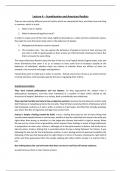Lecture 4 – Scandinavian and American Realists
They are two entirely different sorts of realism which are represented here, and they have one thing
in common, which is to ask:
1. What is law in reality?
2. What fundamental legal facts exist?
In order to make sense of this from what might be described as a rather extreme empiricists stance,
they take the view that what really exists is the behaviour of people.
3. Metaphysical elements must be rejected.
4. This includes rules - You can express the behaviour of people in terms of rules and you can
use rules in order to guide people so their actions are informed with meaning and value. But
that's not quite the same thing.
This means that these Realists reject the idea of law as a set of logical axioms (logical steps), rules and
forms (formalism) that seem it to us as lawyers to have some kind of existence outside of the
behaviour of individuals, whether those are citizens or whether those are officers of state, for
example, such as police and judges and legislators.
Instead they want to study law in action in society – factual occurrences of law as an active function
of social existence, where people operate the law in regulating their actions.
Scandinavian Realists
They were trained philosophers and not lawyers. So they approached the subject from a
philosophical standpoint, and they were interested in a number of ideas which related to the
structures of people's behaviour as a society, both as individuals and collectively.
They rejected morality and natural law as objective systems, because the Scandinavian realists really
didn't believe in metaphysical items like morality. They felt that society had forms of behaviour which
had developed, evolved, as it were, within a society as it got larger. And that that, broadly speaking,
was where the idea of regularity and legal rules comes from.
Justice is simply a feeling created by habit. It was a feeling that acted as one of those things that
causally made people behave in certain ways, whether it was the individual who chose to do what was
right rather than wrong, or whether it is the judge who chooses that which is right or wrong. When
the law acts as a kind of set of generalities which express these feelings in terms of legal statements
or propositions or even rules. Justice is, although not in the same manner as Kelson, but similar to his
idea of justice, simply a feeling that is associated when the law is being followed. For Kelson, it was
following the law, but for the Scandinavian realists, it was a feeling almost of approval created by the
following of the law that doing what the right thing is in terms of humans choosing the right kind of
action and then going about their life socially, dealing with others within society in a manner that is
just.
But nothing about law can be known that does not rest on real facts of human existence.
So what facts are there in law? Human actions.
, Generally, the Scandinavian realists, whilst they rejected morality and natural law, whilst they rejected
the idea of justice as a kind of moral ideal, nonetheless were greatly informed in a number of different
areas. They studied our psychological (particularly by the ideas of behaviourism), social and economic
motivations that together produce the sense of obligation which is distinctive of law.
Hart was again influenced by the Scandinavian realists in this regard, that there were some
psychological, social and economic motivations which give rise to this idea of obligation. Hart himself
put it as a social pressure to conform, which is slightly different, but nonetheless, his writings are
informed by these ideas, just as the Scandinavian realists were.
1. Axel Hägerström – methodology, word magic
First of the Scandinavian realists who was writing at the beginning of the 20 th century.
• Firstly, he takes the stance that the language of law is nothing but illusion.
What very often is the motivation behind realisms in general, both in Scandinavia and America, in that
the realists were taking a stand against reacting against what is called formalism. The idea the law is
made up of a series of rules, and if you fall within the scope of a rule, then the rules are added together
logically to produce some kind of argument that ended up with saying that a person's actions were
right or wrong and that they have certain consequences.
It is a description of what happens in an ordered society. It is not what the law says that matters. It is
what people do. The law can act as part of the motivation, but in the end of the day, it's just a bit of
the picture.
• Onion analogy – tear off the layers to get to the heart of the onion – where there is life.
Getting into his methodology, Hägerström took the view that if you looked at the language of the law,
you would get the idea of a concept and you would have to tear off all the accretions to that. The
linguistic and other accretions in order to get to the real heart of what's going on. He likened this
methodology to being a bit like an onion where there are many, many layers. And to get to the living,
the heart of the onion, it's necessary to peel off one layer and then another layer and then another
layer. Finally, you'll get to the centre where there is the life of the law itself, the thing that motivates
individuals and causes them to act socially in the way they do.
In using this onion analysis, he analysed rights, duties, property, justice and so on in terms of regular
human action.
• Fishing illustration
If a person A has the right to fish whilst standing on the banks of a piece of land owned by a person B,
then this right exists when Person A goes on to person B's land, stands on the shore and fishes and
exercises that right, while person B has to forbear from any action to remove person A because he
recognises that person A has the right to fish.
If, on the other hand, person B attempts to remove Person A from the land and to prevent him from
fishing, then person A is the rights holder can go to court and can have the judge find and declare that
the right does exist. And in that way, Person A can enforce the right to fish that he has, and B must
therefore allow him to do so as authorised and empowered by the court.
So rights only exist when exercised by the rights holder or enforced by the court.





